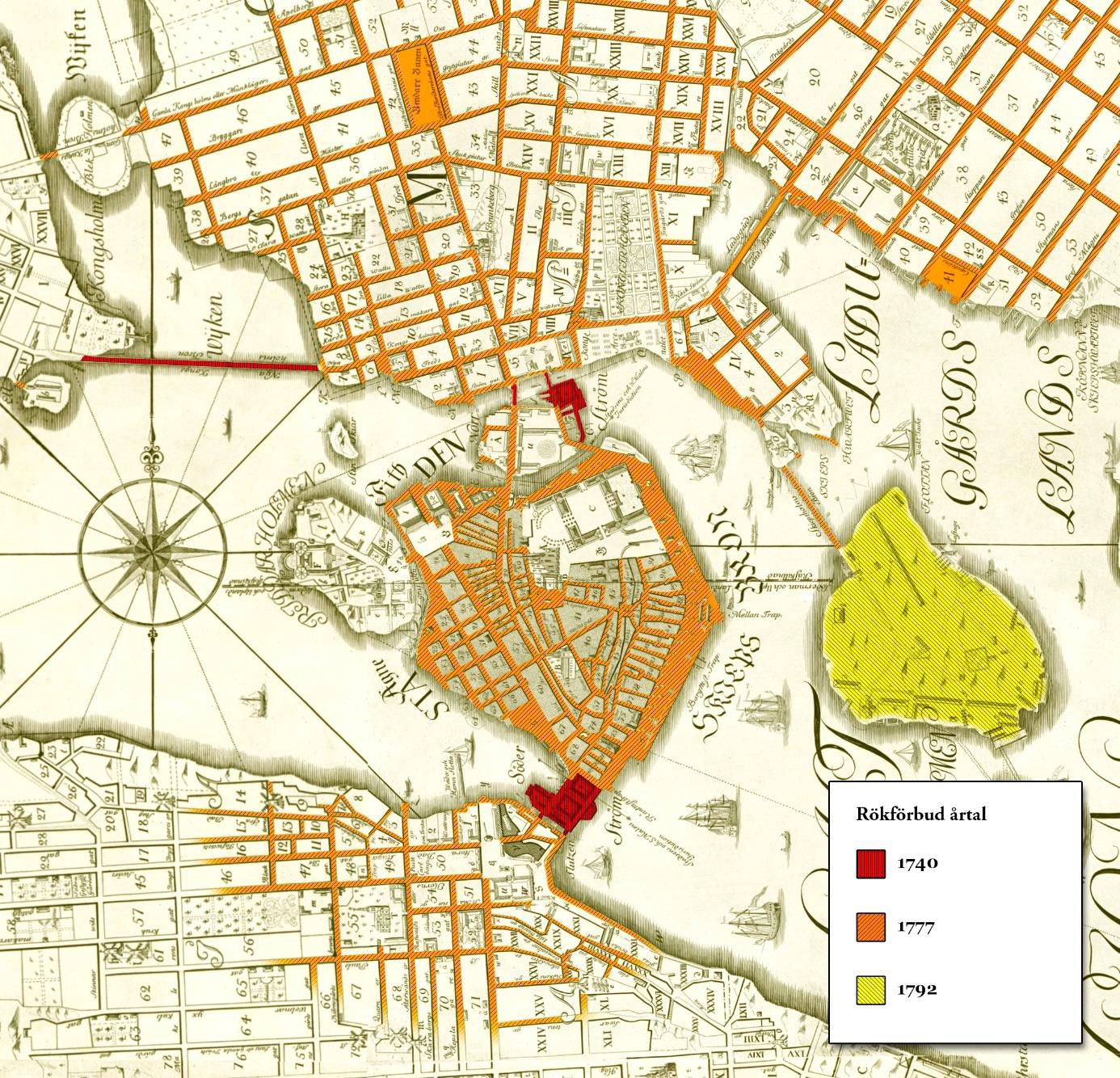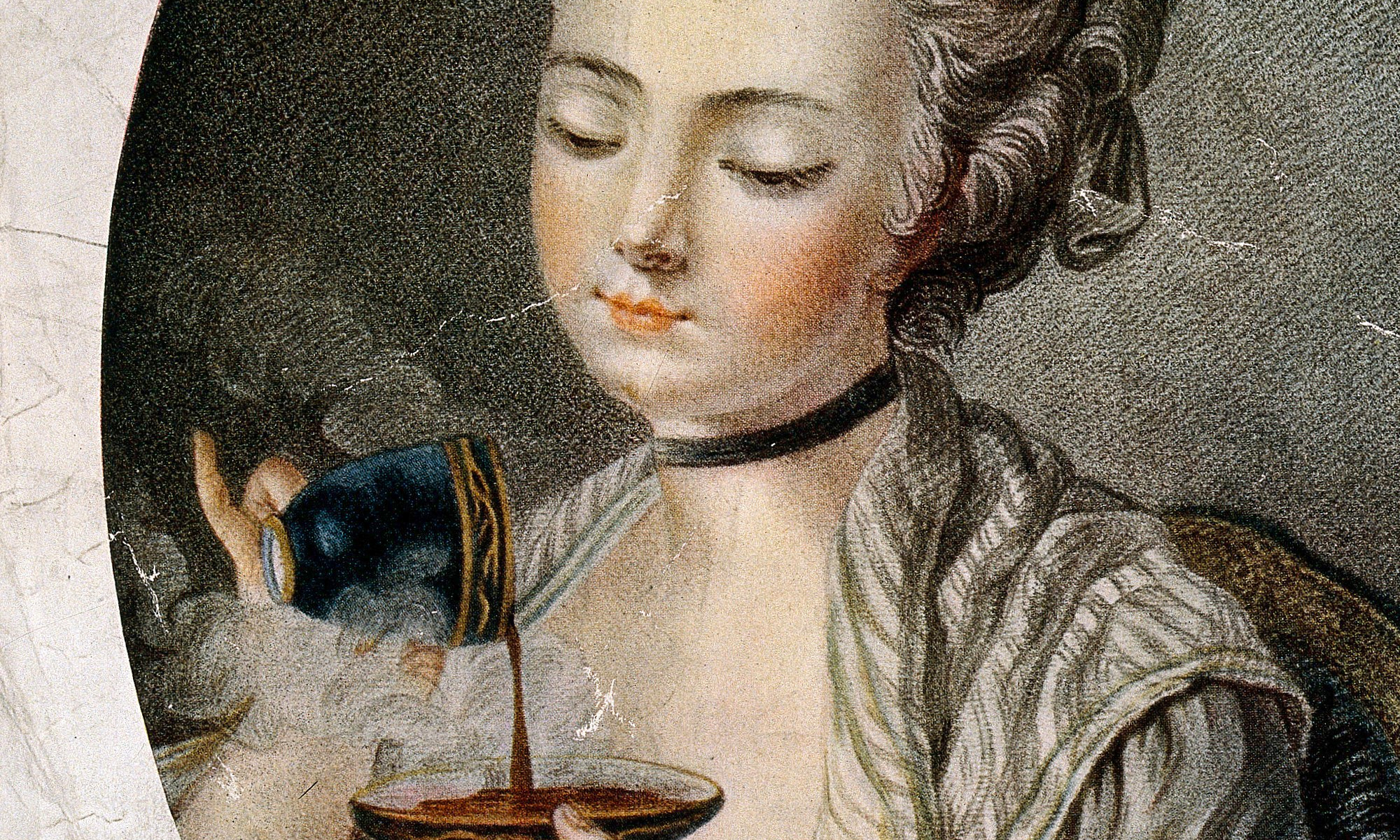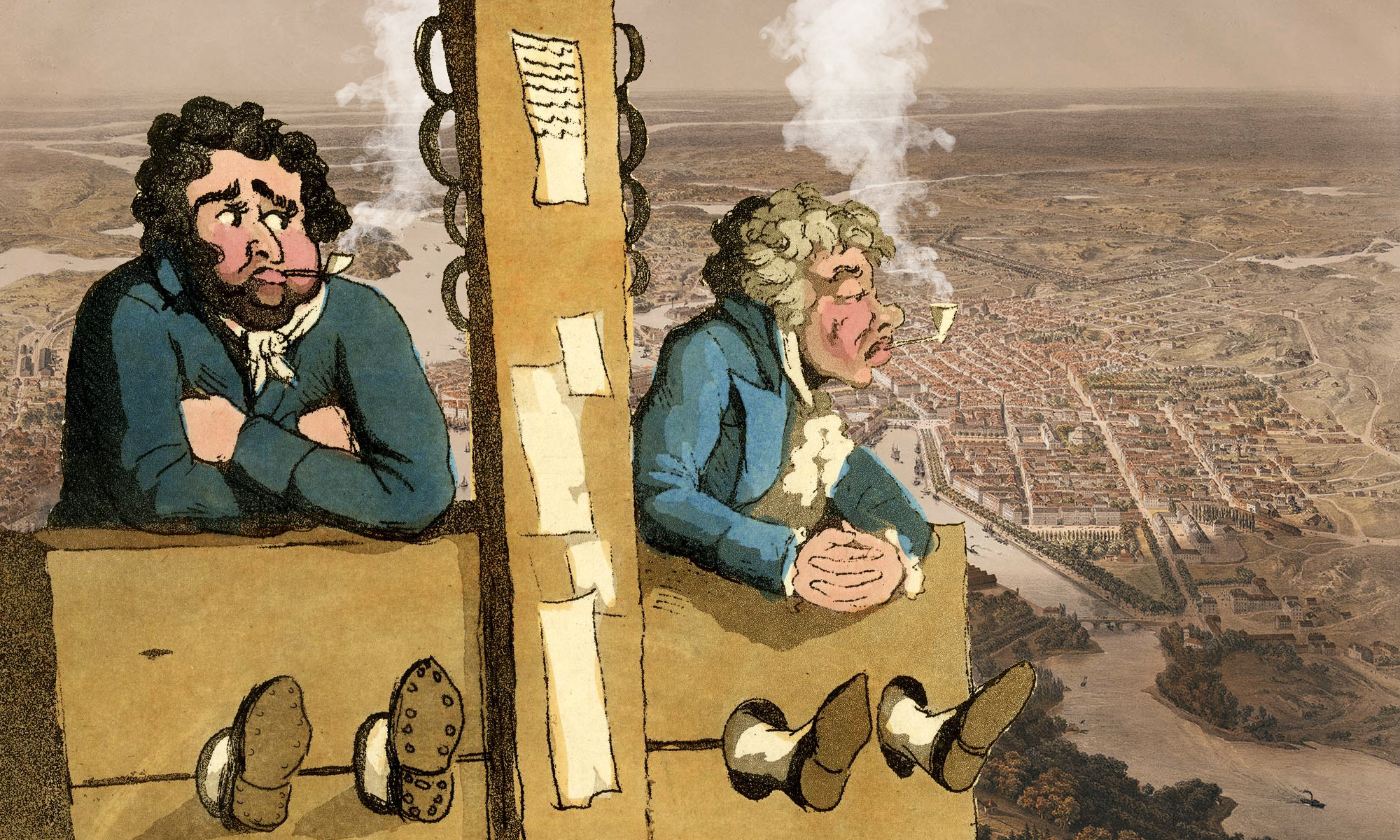Mapping Smoking Bans in Eighteenth-Century Stockholm
Sarah Falk & Hanna Hodacs
Heading across the North and Baltic Seas, this map of Stockholm captures the expansion of the city’s smoke-free-zones between the 1740s and the 1790s. Different colours (red, orange, and yellow) have been applied to a city plan from 1733, drawn by Petrus Tilleus, to illustrate which areas were added and when. It was ostensibly the fire hazard that motivated the authorities to ban smoking. Starting in 1740, the first ban covered the central bridges which linked the different parts of Stockholm. In 1777, most of the densely populated neighbourhoods of the city were added. The island of Skeppsholmen, the headquarters of the Swedish navy, was finally incorporated in 1792. [1] The birds-eye perspective of the map, however, only tells one story; if we study the wording of the regulations, as well as their implementation, we can discern social contours and discreet hideouts for smokers, as well the contradictory effects of the regulations.

As an early modern intoxicant goes, tobacco had a great popular reach. Soldiers exposed to tobacco smoking during Sweden’s many continental wars in the seventeenth century brought the habit home with them. [2] The fact that it was possible to grow tobacco in Scandinavia was probably another important reason for why its consumption took hold. Keen to reduce foreign imports, eighteenth-century Swedish politicians encouraged domestic tobacco cultivation, including on land in the periphery of capital. [3] While snuff became a popular product among the elite, including among female consumers, smoking continued to hold wide appeal. This was not unproblematic to the authorities, who identified plebeian male smokers as a threat to the city. It was their careless albeit unintentionally dangerous manner of ‘associating with fire’, smoking in ‘an unprotected and loose manner’, that posed the problem. [4]
That the risk of fire indoors and outdoors was the main objective behind the regulations is evident; the 1777 regulation, for example, states that the main concern was smoking tobacco in streets, houses, and rooms which easily could ignite. [5] An investigation of police court material from the nine-month period after the 1793 regulation was implemented (21 August 1793), however, suggests that the police upheld the smoking ban in a more limited way. All of the culprits brought before the court during this period were caught smoking outside. Among the specific place references in the 14 cases we find two references to illegal smoking in courtyards, with the rest referring to streets (six), squares (one), and quays and ships (two and five respectively). [6] In other words, the police focused solely on outdoor smokers, and particularly on those who broke the ban in public spaces. We can compare this to the how Stockholm police implemented another contemporary regulation which prohibited coffee in the 1790s and early 1800s; in these cases, police focused almost exclusively on women caught in the act of making, selling, and drinking coffee indoors. [7] While the coffee bans sought to limit the import of exotic goods, what the two laws have in common is how they affected individuals from lower end of the social spectrum. In the coffee cases most culprits were maids; likewise, the majority of male smokers (10 out of 14) prosecuted by the police between August 1793 and May 1794 were journeymen, servants, and sailors. [8] The sample is admittedly too small to draw major conclusions, but it does suggest the existence of social contours not visible in the map representing the geographical expansion of the smoking ban. Those who could smoke privately in the comfort of their own dwellings were protected, while those who moved around in the city as part of their daily life (running errands, working, or just hanging around) were exposed to the prying eyes of the police.
Another way in which the map illustrating the expansion of no-smoking zones only tells part of the story is that it fails to register the hide-outs of the smokers. Focusing on more static elements – buildings grid-systems, borders between private and public – maps typically do not pay attention to more temporary fixtures in the cityscape such as sheds, lumber, and piles of stuff. Depending on which perspective we favour, such discrete, makeshift, and transitory places take on different meanings. From the point of view of the city authorities, a major concern were places that contained firewood, coal, fodder, hay, and straw.[9] Not surprisingly, sheds, stables, attics, or cellars containing such materials were explicitly prohibited to smoke in. On the other hand, and thinking like a smoker, such places, together with carriage houses, workshops (also mentioned in the regulations) and other environments only partially occupied by others, offered ideal hiding places for enjoying a pipe.[10] A case from 1795 illustrates how the two objectives clashed; it tells the story of the innkeeper Husting who was found by the police on a Sunday in July, in the storage sheds belonging to the city, ‘where planer buckle was kept… smoking tobacco’. [11] While only one case it is sufficient to underline the contradictory nature of the smoking ban. How would a smoker view Stockholm, then? Perhaps Elias Martin’s (1739–1818) vista of the northern part of the city can help us, suggesting ample hideouts in the buzzling city.
References
[1] The regulations are reprinted in R. G.Modée (ed.), Utdrag utur alle ifrån den 7. decemb. 1718 [-1794] utkomne publique handlingar, placater, förordningar, resolutioner ock publicationer, som riksens styrsel samt inwärtes hushållning ock författningar i gemen, jämwäl ock Stockholms stad i synnerhet angå, Vols 1–15 (Stockholm 1742–1829).
[2] Förbud 16/9 1741, Modée 1749, Vol. 3, 1735. See also, R. B. Carter, ‘Vem rökte alla dessa pipor? – en historisk-arkeologisk studie av kritpipor och rökning i 1600- och 1700-talens Sverige med genus- och intersektionalitetsperspektiv’, BA thesis (Lund University, 2013).
[3] M. Morell, ‘Swedish Agriculture in the Cosmopolitan Eighteenth-Century Sweden’, in G. Rydén (ed.), Sweden in the Eighteenth-Century World: Provincial Cosmopolitans (Farnham, 2013), pp. 86–88.
[4] Förbud 19/7 1777, Modée, Utdrag, Vol. 11, pp. 260–261; Förbud 21/8 1793, Modée, Utdrag, Vol. 15, p. 465.
[5] Förbud 19/7 1777, Modée, Utdrag, Vol. 11, pp. 260–261.
[6] Falk, ‘Ingen må röka tobak’, p. 37.
[7] A. Knutsson & H. Hodacs, ‘When Coffee was Banned: Strategies of Labour and Leisure Among Stockholm’s Poor Women, 1794–1796 and 1799–1802’, Scandinavian Economic History Review (2021).
[8] Falk, ‘Ingen må röka tobak’, p. 34.
[9] Förbud 21/8 1793, Modée, Utdrag, Vol. 15, pp. 465–466.
[10] Ibid.
[11] 21 July, 1795, Överståthållarämbetet för polisärenden 1, Äldre poliskammaren, Diarium, CIa1, Vol. 22, (SCA).

